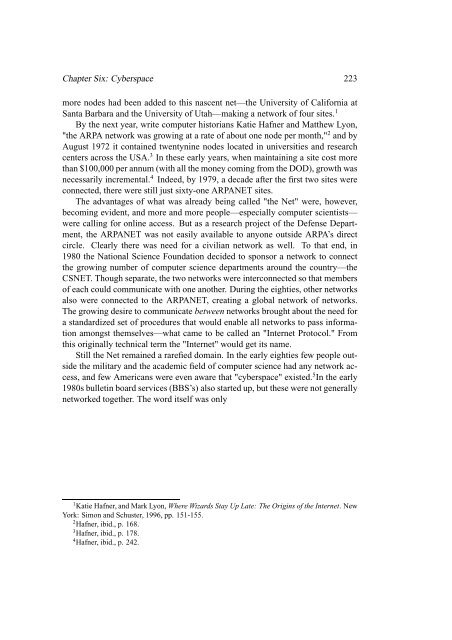The Pearly Gates of Cyberspace: - University of Exeter
The Pearly Gates of Cyberspace: - University of Exeter
The Pearly Gates of Cyberspace: - University of Exeter
You also want an ePaper? Increase the reach of your titles
YUMPU automatically turns print PDFs into web optimized ePapers that Google loves.
Chapter Six: <strong>Cyberspace</strong> 223<br />
more nodes had been added to this nascent net—the <strong>University</strong> <strong>of</strong> California at<br />
Santa Barbara and the <strong>University</strong> <strong>of</strong> Utah—making a network <strong>of</strong> four sites. 1<br />
By the next year, write computer historians Katie Hafner and Matthew Lyon,<br />
"the ARPA network was growing at a rate <strong>of</strong> about one node per month," 2 and by<br />
August 1972 it contained twentynine nodes located in universities and research<br />
centers across the USA. 3 In these early years, when maintaining a site cost more<br />
than $100,000 per annum (with all the money coming from the DOD), growth was<br />
necessarily incremental. 4 Indeed, by 1979, a decade after the first two sites were<br />
connected, there were still just sixty-one ARPANET sites.<br />
<strong>The</strong> advantages <strong>of</strong> what was already being called "the Net" were, however,<br />
becoming evident, and more and more people—especially computer scientists—<br />
were calling for online access. But as a research project <strong>of</strong> the Defense Department,<br />
the ARPANET was not easily available to anyone outside ARPA’s direct<br />
circle. Clearly there was need for a civilian network as well. To that end, in<br />
1980 the National Science Foundation decided to sponsor a network to connect<br />
the growing number <strong>of</strong> computer science departments around the country—the<br />
CSNET. Though separate, the two networks were interconnected so that members<br />
<strong>of</strong> each could communicate with one another. During the eighties, other networks<br />
also were connected to the ARPANET, creating a global network <strong>of</strong> networks.<br />
<strong>The</strong> growing desire to communicate between networks brought about the need for<br />
a standardized set <strong>of</strong> procedures that would enable all networks to pass information<br />
amongst themselves—what came to be called an "Internet Protocol." From<br />
this originally technical term the "Internet" would get its name.<br />
Still the Net remained a rarefied domain. In the early eighties few people outside<br />
the military and the academic field <strong>of</strong> computer science had any network access,<br />
and few Americans were even aware that "cyberspace" existed. 5 In the early<br />
1980s bulletin board services (BBS’s) also started up, but these were not generally<br />
networked together. <strong>The</strong> word itself was only<br />
1 Katie Hafner, and Mark Lyon, Where Wizards Stay Up Late: <strong>The</strong> Origins <strong>of</strong> the Internet. New<br />
York: Simon and Schuster, 1996, pp. 151-155.<br />
2 Hafner, ibid., p. 168.<br />
3 Hafner, ibid., p. 178.<br />
4 Hafner, ibid., p. 242.

















